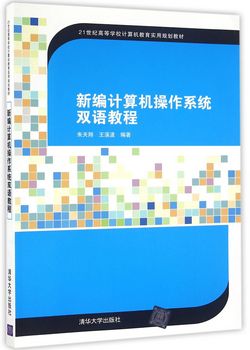新编计算机操作系统双语教程 / 21世纪高等学校计算机教育实用规划教材
定价:¥44.50
作者: 朱天翔,王溪波
出版时间:2016-09
出版社:清华大学出版社
- 清华大学出版社
- 9787302438212
- 1-1
- 39376
- 16开
- 2016-09
- TP316
- 计算机
内容简介
本教材的创新点是采用双语制,提供中英文教学素材,适应高等院校所提倡的双语教学模式,响应国际型人才培养战略的要求。在内容的编排上,每章后面将本章的主要概念、原理和算法附上英文教学内容。既可作为高等院校计算机相关专业的计算机操作系统课程的双语教材,也可供广大师生自学之用。 本书介绍了计算机操作系统的基本概念、原理和相关的技术。从计算技术的产生到操作系统的发展,从单机批处理操作到多道程序系统的实现,由浅入深、循序渐进,构成计算机操作系统的整体架构。全书共分8章,分别介绍计算机操作系统的基本概念;讲述处理机的管理内容,包括进程管理、进程同步、进程通信等;介绍内存管理和虚拟存储器的实现;阐述文件管理、设备管理的相关知识。
目录
第1章 操作系统引论 1
1.1 计算机的基本工作原理 1
1.1.1 自动计算 1
1.1.2 计算机基础 1
1.2 操作系统的产生 5
1.2.1 早期计算机的使用 5
1.2.2 批处理系统 6
1.2.3 分时系统 8
1.2.4 实时系统 9
1.3 操作系统的概念 9
1.3.1 操作系统的定义 9
1.3.2 操作系统与计算机其他软件及硬件的关系 10
1.3.3 操作系统的使用 11
1.4 操作系统的引导 11
1.5 操作系统特征 13
1.6 操作系统组成 14
1.6.1 处理机管理 14
1.6.2 内存管理 15
1.6.3 文件管理 16
1.6.4 设备管理 17
Chapter 1 Introduction to Computer 18
1.1 The Basic Principle of Computer 18
1.1.1 Computer Architecture 18
1.1.2 Computer System 19
1.2 Operating System Concepts 20
1.2.1 Operating System Definitions 20
1.2.2 Use of the Operating System 21
1.2.3 Operating System Several Related Concepts 22
1.3 System Components 23
1.3.1 Process Management 23
1.3.2 Memory Management 24
1.3.3 File-System Management 25
1.3.4 I/O Systems 26
习题 26
第2章 进程管理 29
2.1 计算机程序的执行 29
2.1.1 计算机程序执行 29
2.1.2 多道程序的执行 30
2.2 进程 30
2.2.1 进程概念的引入 30
2.2.2 进程的概念 31
2.2.3 进程与程序的关系 31
2.2.4 进程的特征 32
2.3 进程控制块 32
2.3.1 进程控制块概述 32
2.3.2 进程控制块的内容 32
2.3.3 Linux的进程控制块 33
2.3.4 进程控制块的组织方式 34
2.4 进程的状态 35
2.4.1 进程基本状态 35
2.4.2 进程基本状态的转换 36
2.4.3 带挂起的进程状态 37
2.5 进程控制 38
2.5.1 进程的创建 38
2.5.2 进程的终止 40
2.6 处理机调度 41
2.6.1 处理机调度的层次 41
2.6.2 进程调度的功能及实现方式 43
2.7 调度算法 45
2.7.1 调度算法的性能评价准则 45
2.7.2 先来先服务调度算法 46
2.7.3 短作业优先调度算法 47
2.7.4 高优先权优先调度算法 49
2.7.5 基于时间片的轮转调度算法 50
2.8 实时调度 52
2.8.1 实时调度的基本条件 53
2.8.2 实时调度算法 55
Chapter 2 Process Management 58
2.1 Process Concepts 58
2.1.1 Process Concepts 58
2.1.2 Process and Program 58
2.2 Process Control Block 59
2.2.1 Process Control Block 59
2.2.2 Process Control Block Contents 59
2.3 Process State 60
2.3.1 Basic States of a Process 60
2.3.2 Process State Change 61
2.3.3 Process State with the Pending 62
2.4 Operations on Processes 63
2.4.1 Process Creation 63
2.4.2 Termination of Process 64
2.5 CPU Scheduling 65
2.5.1 Queues and Schedulers 65
2.5.2 Schedule Criteria 68
2.5.3 First-Come, First-Served Scheduling 69
2.5.4 Shortest-Job-First Scheduling 70
2.5.5 Priority Scheduling 72
2.5.6 Round-Robin Scheduling 73
习题 74
第3章 进程同步 78
3.1 计算机程序的并发执行 78
3.1.1 程序的并发执行 78
3.1.2 前趋图 80
3.2 进程同步 81
3.2.1 临界资源与临界区 81
3.2.2 信号量 82
3.2.3 进程同步 83
3.2.4 改进的信号量机制 84
3.3 经典同步问题 88
3.3.1 生产者-消费者问题 88
3.3.2 读者-写者问题 91
3.3.3 哲学家问题 93
3.4 死锁 94
3.4.1 死锁的产生 94
3.4.2 预防死锁 96
3.4.3 死锁的检测与解除 101
3.5 管程 103
Chapter 3 Process Synchronization 106
3.1 Process Synchronization 106
3.1.1 Critical Section 106
3.1.2 Semaphore 106
3.2 Classic Problems of Synchronization 110
3.2.1 Producer-Consumer (Bounded-Buffer) Problem 110
3.2.2 The Readers-Writers Problem 111
3.3 Deadlocks 113
3.3.1 Causes of Deadlocks 113
3.3.2 Deadlock Avoidance 115
习题 119
第4章 进程通信与多线程 126
4.1 进程通信 126
4.1.1 共享存储区通信 126
4.1.2 消息传递系统 127
4.1.3 管道通信 130
4.1.4 Socket通信 131
4.2 多核技术 134
4.2.1 并行计算机 135
4.2.2 多核处理器 136
4.2.3 操作系统对多核处理器的支持方法 137
4.3 线程与线程管理 139
4.3.1 线程 139
4.3.2 线程管理 141
4.4 多线程的实现 143
4.4.1 典型的实现方式 143
4.4.2 用户级线程实现 145
4.4.3 核心级线程实现 146
Chapter 4 Interprocess Communicationand and Multi-Threading 148
4.1 Interprocess Communication 148
4.1.1 Shared-Memory Systems 148
4.1.2 Message-Passing Systems 148
4.1.3 pipe 150
4.1.4 Socket Communication 151
4.2 Multiprocessor Systems 151
4.3 Threads 152
4.3.1 Motivation 152
4.3.2 Multithreading Models 153
习题 154
第5章 内存管理 155
5.1 重定位 155
5.2 分区式管理 156
5.2.1 单一连续区分配 157
5.2.2 固定分区分配 157
5.2.3 可变式分区 159
5.3 分页式管理 164
5.3.1 分页的基本工作原理 164
5.3.2 动态地址变换 166
5.3.3 快表 168
5.3.4 两级和多级页表 169
5.4 分段式管理 171
5.4.1 分段的基本工作原理 171
5.4.2 地址变换 172
5.4.3 分段管理的信息共享 173
5.5 段页式管理 174
5.5.1 段页式的基本工作原理 174
5.5.2 地址变换 175
Chapter 5 Memory Management 177
5.1 Address Binding 177
5.2 Continuous Memory Allocation 179
5.3 Paging 181
5.3.1 Basic Method 181
5.3.2 Caching 183
5.3.4 Hierarchical Paging 185
5.4 Segmentation 185
习题 187
第6章 虚拟存储器 192
......
1.1 计算机的基本工作原理 1
1.1.1 自动计算 1
1.1.2 计算机基础 1
1.2 操作系统的产生 5
1.2.1 早期计算机的使用 5
1.2.2 批处理系统 6
1.2.3 分时系统 8
1.2.4 实时系统 9
1.3 操作系统的概念 9
1.3.1 操作系统的定义 9
1.3.2 操作系统与计算机其他软件及硬件的关系 10
1.3.3 操作系统的使用 11
1.4 操作系统的引导 11
1.5 操作系统特征 13
1.6 操作系统组成 14
1.6.1 处理机管理 14
1.6.2 内存管理 15
1.6.3 文件管理 16
1.6.4 设备管理 17
Chapter 1 Introduction to Computer 18
1.1 The Basic Principle of Computer 18
1.1.1 Computer Architecture 18
1.1.2 Computer System 19
1.2 Operating System Concepts 20
1.2.1 Operating System Definitions 20
1.2.2 Use of the Operating System 21
1.2.3 Operating System Several Related Concepts 22
1.3 System Components 23
1.3.1 Process Management 23
1.3.2 Memory Management 24
1.3.3 File-System Management 25
1.3.4 I/O Systems 26
习题 26
第2章 进程管理 29
2.1 计算机程序的执行 29
2.1.1 计算机程序执行 29
2.1.2 多道程序的执行 30
2.2 进程 30
2.2.1 进程概念的引入 30
2.2.2 进程的概念 31
2.2.3 进程与程序的关系 31
2.2.4 进程的特征 32
2.3 进程控制块 32
2.3.1 进程控制块概述 32
2.3.2 进程控制块的内容 32
2.3.3 Linux的进程控制块 33
2.3.4 进程控制块的组织方式 34
2.4 进程的状态 35
2.4.1 进程基本状态 35
2.4.2 进程基本状态的转换 36
2.4.3 带挂起的进程状态 37
2.5 进程控制 38
2.5.1 进程的创建 38
2.5.2 进程的终止 40
2.6 处理机调度 41
2.6.1 处理机调度的层次 41
2.6.2 进程调度的功能及实现方式 43
2.7 调度算法 45
2.7.1 调度算法的性能评价准则 45
2.7.2 先来先服务调度算法 46
2.7.3 短作业优先调度算法 47
2.7.4 高优先权优先调度算法 49
2.7.5 基于时间片的轮转调度算法 50
2.8 实时调度 52
2.8.1 实时调度的基本条件 53
2.8.2 实时调度算法 55
Chapter 2 Process Management 58
2.1 Process Concepts 58
2.1.1 Process Concepts 58
2.1.2 Process and Program 58
2.2 Process Control Block 59
2.2.1 Process Control Block 59
2.2.2 Process Control Block Contents 59
2.3 Process State 60
2.3.1 Basic States of a Process 60
2.3.2 Process State Change 61
2.3.3 Process State with the Pending 62
2.4 Operations on Processes 63
2.4.1 Process Creation 63
2.4.2 Termination of Process 64
2.5 CPU Scheduling 65
2.5.1 Queues and Schedulers 65
2.5.2 Schedule Criteria 68
2.5.3 First-Come, First-Served Scheduling 69
2.5.4 Shortest-Job-First Scheduling 70
2.5.5 Priority Scheduling 72
2.5.6 Round-Robin Scheduling 73
习题 74
第3章 进程同步 78
3.1 计算机程序的并发执行 78
3.1.1 程序的并发执行 78
3.1.2 前趋图 80
3.2 进程同步 81
3.2.1 临界资源与临界区 81
3.2.2 信号量 82
3.2.3 进程同步 83
3.2.4 改进的信号量机制 84
3.3 经典同步问题 88
3.3.1 生产者-消费者问题 88
3.3.2 读者-写者问题 91
3.3.3 哲学家问题 93
3.4 死锁 94
3.4.1 死锁的产生 94
3.4.2 预防死锁 96
3.4.3 死锁的检测与解除 101
3.5 管程 103
Chapter 3 Process Synchronization 106
3.1 Process Synchronization 106
3.1.1 Critical Section 106
3.1.2 Semaphore 106
3.2 Classic Problems of Synchronization 110
3.2.1 Producer-Consumer (Bounded-Buffer) Problem 110
3.2.2 The Readers-Writers Problem 111
3.3 Deadlocks 113
3.3.1 Causes of Deadlocks 113
3.3.2 Deadlock Avoidance 115
习题 119
第4章 进程通信与多线程 126
4.1 进程通信 126
4.1.1 共享存储区通信 126
4.1.2 消息传递系统 127
4.1.3 管道通信 130
4.1.4 Socket通信 131
4.2 多核技术 134
4.2.1 并行计算机 135
4.2.2 多核处理器 136
4.2.3 操作系统对多核处理器的支持方法 137
4.3 线程与线程管理 139
4.3.1 线程 139
4.3.2 线程管理 141
4.4 多线程的实现 143
4.4.1 典型的实现方式 143
4.4.2 用户级线程实现 145
4.4.3 核心级线程实现 146
Chapter 4 Interprocess Communicationand and Multi-Threading 148
4.1 Interprocess Communication 148
4.1.1 Shared-Memory Systems 148
4.1.2 Message-Passing Systems 148
4.1.3 pipe 150
4.1.4 Socket Communication 151
4.2 Multiprocessor Systems 151
4.3 Threads 152
4.3.1 Motivation 152
4.3.2 Multithreading Models 153
习题 154
第5章 内存管理 155
5.1 重定位 155
5.2 分区式管理 156
5.2.1 单一连续区分配 157
5.2.2 固定分区分配 157
5.2.3 可变式分区 159
5.3 分页式管理 164
5.3.1 分页的基本工作原理 164
5.3.2 动态地址变换 166
5.3.3 快表 168
5.3.4 两级和多级页表 169
5.4 分段式管理 171
5.4.1 分段的基本工作原理 171
5.4.2 地址变换 172
5.4.3 分段管理的信息共享 173
5.5 段页式管理 174
5.5.1 段页式的基本工作原理 174
5.5.2 地址变换 175
Chapter 5 Memory Management 177
5.1 Address Binding 177
5.2 Continuous Memory Allocation 179
5.3 Paging 181
5.3.1 Basic Method 181
5.3.2 Caching 183
5.3.4 Hierarchical Paging 185
5.4 Segmentation 185
习题 187
第6章 虚拟存储器 192
......


















